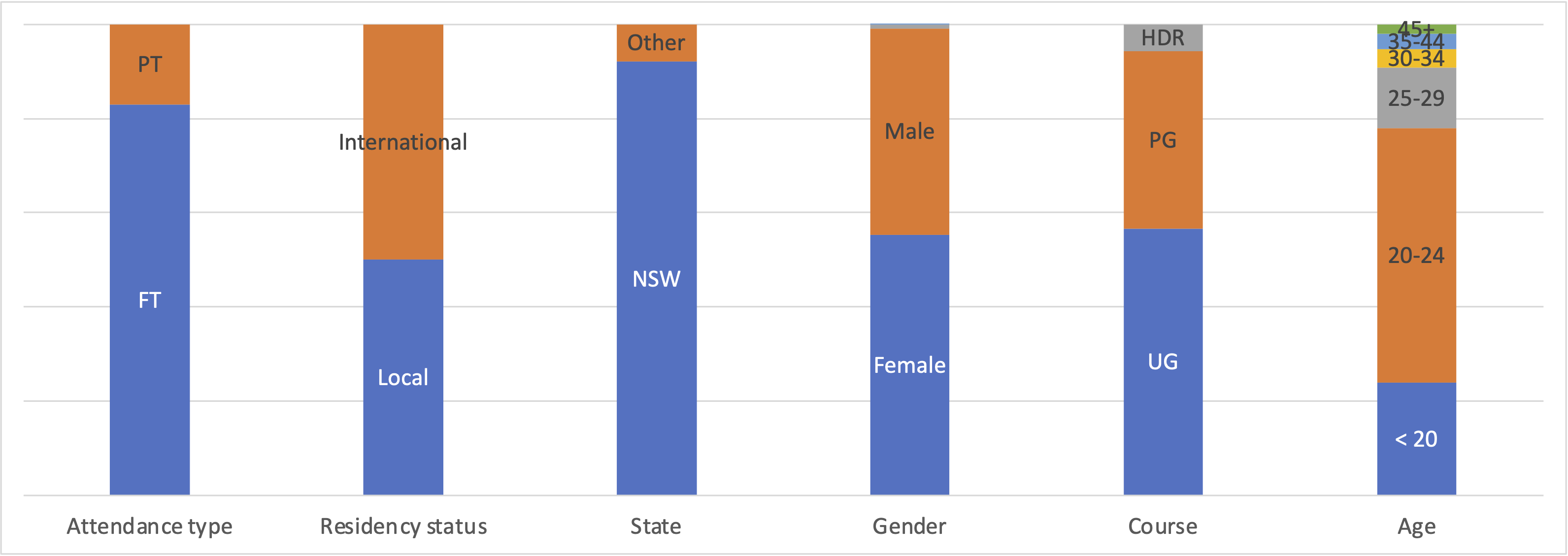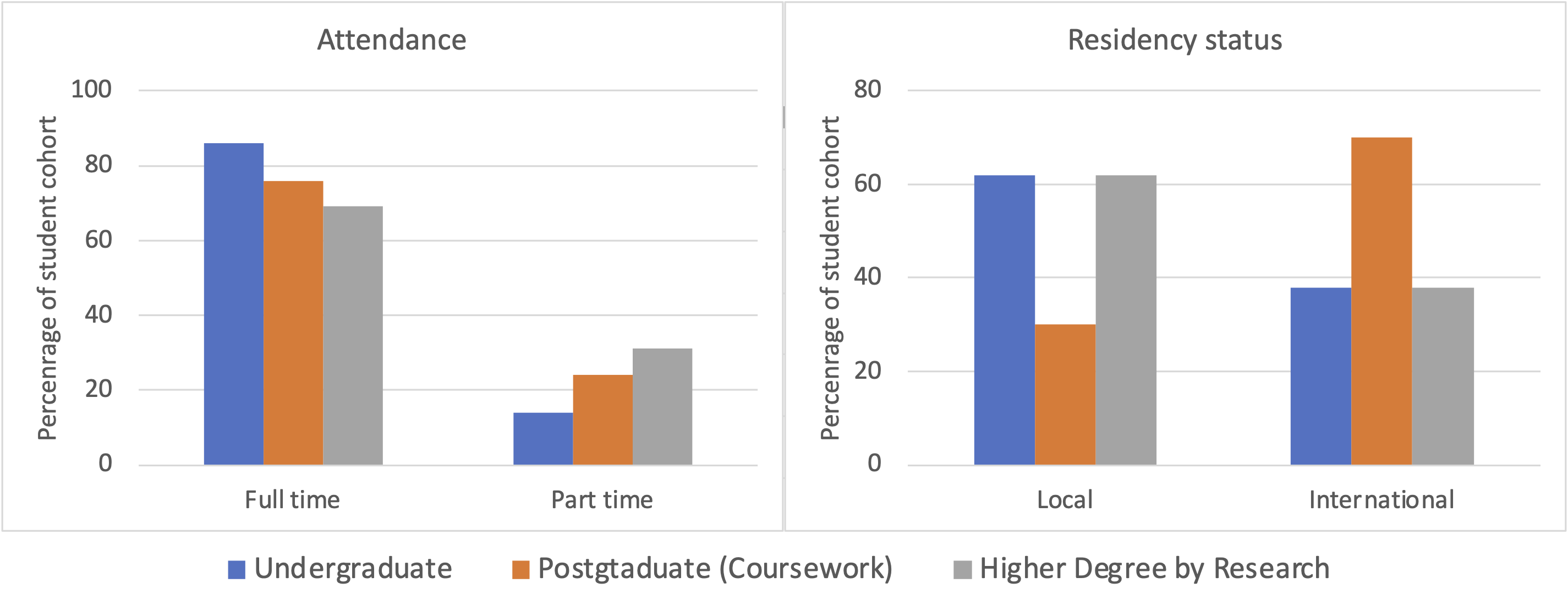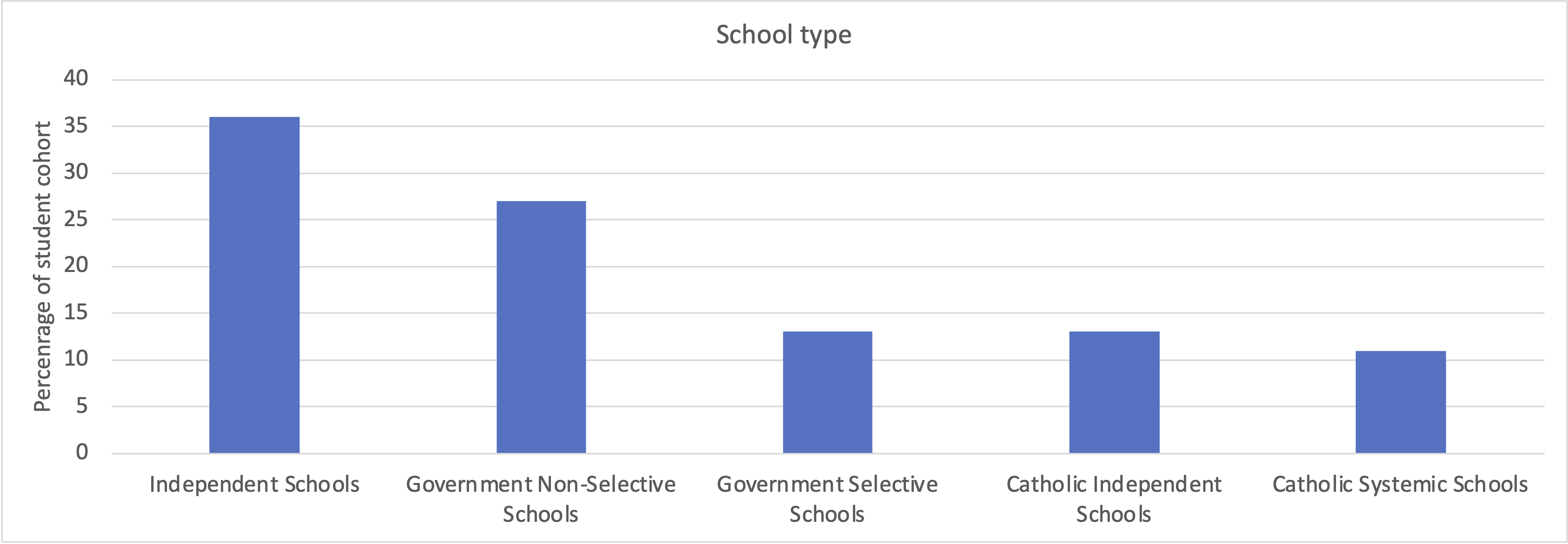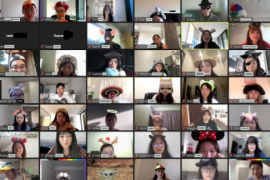This article has been updated from the original (2021), and the 2022 and 2023 versions, to include data covering our current students.
Our students come from many countries and places, with varied life experiences, different learning backgrounds, and diverse perspectives. The University of Sydney is committed through its visions and values to cultivating a teaching and learning environment which is stronger because of this diversity. Our shared educational philosophy commits us all to build “a diverse, inclusive and intellectually exciting environment” for students, while our 2032 Strategy aspirations envision a community that is increasingly diverse and inclusive.
But what does this diversity actually look like in practice? Are our undergraduates all recent school leavers studying full-time? Which countries do our international students call home? How many of our students are the first in their families to attend university? Does our student body reflect the diversity of our city, state and region?
This diversity isn’t just numbers on a page – it’s the foundation of rich educational experiences that prepare our students for an interconnected world. When students engage with peers from different backgrounds, they develop critical thinking skills, cultural competence, and the ability to navigate complexity – all essential graduate attributes.
This article provides a snapshot of student diversity at Sydney based on our 2025 enrolment data, along with practical strategies for embracing this diversity in your teaching practice.
Student diversity at the University of Sydney
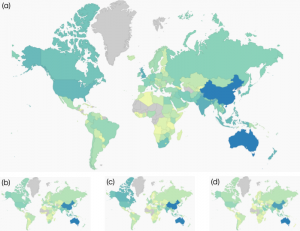
Student diversity at our university is multifaceted and intersecting. While some aspects are readily visible in our data – such as country of origin, age, or study patterns – others reflect deeper dimensions of student experience and identity.
Visible dimensions of diversity
Our students vary across numerous measurable characteristics:
Geographic and cultural backgrounds: Students arrive from many countries with different residency statuses, bringing varied cultural perspectives and educational experiences from different school systems and pedagogical approaches.
Demographics and study patterns: Our community includes students of all ages studying full-time or part-time, pursuing undergraduate degrees, postgraduate coursework, or higher degrees by research.
Equity backgrounds: Many students come from backgrounds that have been historically underrepresented in higher education, including those from low socioeconomic, regional/remote, Aboriginal and Torres Strait Islander, disability, first-in-family, non-English speaking, refugee, mature-age, and educationally disadvantaged backgrounds.
Beyond these categories, our students bring diverse:
- Values, beliefs, attitudes, and expectations about education
- Worldviews and cultural lenses that shape how they interpret and engage with learning
- Prior educational experiences that influence their learning preferences and approaches
Diversity can be visible and invisible, and often intersecting – we are never just one thing.
A snapshot of student diversity in 2025
At a glance, at the end of semester 1, 2025:
International and cultural diversity:
- 38% of undergraduate students are international (↑3% from 2021)
- 35% of all enrolments are from non-English speaking backgrounds
- Students represent many countries with varied educational and cultural experiences
Gender and identity:
- 55% of undergraduate students identify as female
- 59% of postgraduate coursework students identify as female
- 52% of research students identify as female
- Significant growth in students who do not identify as male or female (10x increase since 2021)
Equity and access:
- ~2,900 students from low socioeconomic backgrounds
- ~600 Aboriginal and Torres Strait Islander students
- ~5,300 students identify as living with disability (~13% of domestic students)
- ~2,500 students from regional areas
- ~80 students from remote areas
- ~2,000 students from non-English speaking backgrounds
Study patterns and pathways:
- 71% of new undergraduates came directly from high school (↓4% since 2022)
- 29% of undergraduates entered through alternative pathways
Equity cohort distribution at the end of Semester 1, 2025
Note: Gender percentages may not total 100% due to students who identify as non-binary or prefer not to specify
Key trends and insights:
- Growing international diversity: International undergraduate participation continues to increase
- Changing entry pathways: More students entering university through non-traditional routes
- Growing representation across equity groups: Significant participation from students with disability, regional backgrounds, and diverse cultural backgrounds
- Gender patterns vary by level: Higher female-identifying participation overall, with variations across study levels
Want current data for your specific cohort? Use the Knowing Your Students portal or Student Diversity dashboard to explore your students’ backgrounds and characteristics.
Valuing diversity
Making universities more diverse places has a number of benefits, including (but not limited to):
- exposing students to diverse experiences and opinions,
- exploring different ways of thinking about and living in the world,
- challenging existing power dynamics,
- expanding learning opportunities and methods, and
- opportunities to experience different ways of knowing, being, and doing.
The Green Guide emphasises that diversity is not just about representation—it’s about creating learning environments where all students can thrive by drawing on their unique strengths and perspectives.
Practical tips for getting to know your students
One of the best ways we can support and embrace diversity in our classes is by getting to know our students. By engaging with your students’ backgrounds, needs, learning preferences, and previous experiences, you demonstrate to your students that their voices and perspectives matter. This approach aligns with the Green Guide’s principle of building meaningful relationships as the foundation for equity-focused teaching.
Tips and approaches for getting started:
- Get a quick insight into your student cohort with the Knowing Your Students portal.
- Access the Student Diversity dashboard for visualisations on Sydney Student data on equity groups, including student outcome information (access, retention, participation, success and attainment).
- Pro tip: To access the Student Diversity dashboard, open the Insights Hub and select PowerBI. From your Power BI home, click Apps in the left menu and the Student Diversity dashboard should be in the list.
- Learn your students’ names – some students can go all the way through university without a single person learning their name! This simple act demonstrates that each student matters as an individual.
- Pro-tip: you can use SRES to learn how to pronounce your students’ names
- Pro-tip: use ‘name tents‘ in classes to help everyone learn each other’s names
- Be aware of the correct language to use in different contexts – for example, some students will appreciate recognition of the correct use of pronouns. This reflects the Green Guide’s emphasis on valuing diversity in all its forms.
- Pro-tip: you can now add your pronouns in Canvas
- Listen to student needs – for example, you may organise regular office hours (or Zoom drop-ins for those off campus) every few weeks to talk through any problems they may be having. This approach helps identify and remove structural barriers that might be preventing student success.
- Pro-tip: some (many) students might not know what “office hours” mean, so you may rename this to something that is accessible to all, for example, “chat with your tutor.”
- Use icebreaker activities that help you learn about your student’s prior experiences and circumstances, in addition to creating a welcoming and engaging learning environment. The Green Guide emphasises the importance of embracing strengths-based approaches by recognising the valuable knowledge and experiences students bring to their learning.
- Build a sense of community using platforms like Padlet or Canvas discussion board and reinforce these connections by referencing them in class! This helps create environments where students feel they belong and that their contributions are valued.
Want to go deeper? The Green Guide provides practical, accessible, evidence-based strategies for each of these approaches, including specific techniques for curriculum design, assessment, and feedback that support students from equity backgrounds.
More practical resources
We also have a few Teaching@Sydney articles that cover practical tips for getting to know your students:
- Welcoming students with SRES
- Knowing your Students dashboard gets a facelift
- Start this semester off with SRES
- Online Communication: Scale, Scope and Simplicity in FASS1000
- Making relationship-rich experiences the heart of higher education
Want to know more?
Explore the resources, tools, and professional development below to build your equity-focused teaching practice.
Understanding equity terminology and student groups
➕Review key definitions and concepts to support equity-focused teaching practice
Key concepts in equity-focused teaching
- Equity vs equality: Equality means giving everyone the same resources and opportunities, while equity means recognising individual strengths, interests and aspirations, and providing appropriate opportunities and resources for students to develop their talents and achieve their goals.
- Students from equity backgrounds: Students who are members of particular groups that face systemic barriers to accessing and succeeding in higher education due to their circumstances. This includes both ‘official’ equity groups (recognised by the Australian Government) and ‘equity-like’ groups who face similar barriers.
- Hidden curriculum: The unwritten norms, values, language and expectations that shape the university landscape but aren’t explicitly taught. These can act as barriers for students less familiar with academic culture.
- Mattering: The importance of students feeling noticed, appreciated, and cared for within the educational environment. This goes beyond belonging by focusing on individual relationships and meaningful interactions.
- Intersectionality: Recognition that students’ experiences are shaped by the complex interplay of their multiple social identities. Students who belong to multiple equity groups may face compounded barriers.
‘Official’ equity groups (Australian Government recognised)
- Students from low socioeconomic status (SES) locations: Those from areas with limited access to social, economic and cultural resources
- Students with disability: Those with long-term physical, mental, intellectual or sensory impairments that may hinder full participation
- Aboriginal and Torres Strait Islander students: Students who identify as Indigenous Australian
- Women in non-traditional areas (WINTA): Female students in disciplines like STEM, engineering, and technology
- Students from regional areas: Those from non-major city locations who may face challenges like limited study options and higher relocation costs
- Students from remote areas: Those from geographically isolated areas facing additional access challenges
- Students from non-English speaking backgrounds (NESB): Those who primarily speak a language other than English at home
‘Equity-like’ groups (facing similar barriers)
- First-generation (first-in-family) university students: Those without family members with university-level qualifications
- Pasefika students: Those identifying with or having heritage from Pacific Islands
- Students from culturally and linguistically diverse (CALD) backgrounds: Including NESB students plus those with cultural backgrounds differing from the Australian majority
- Students who are carers: Those providing unpaid care to family members or friends with disabilities, illness or care needs
- Mature-aged students: Those 21+ years at course commencement, often with diverse backgrounds and circumstances
- Students from refugee backgrounds: Those granted humanitarian protection or seeking asylum
- LGBTQIA+ students: Those identifying as lesbian, gay, bisexual, transgender, queer, intersex, asexual or other non-heteronormative identities
- Veterans: Students who have served in the Australian Defence Force
Definitions adapted from the Green Guide: Enhancing the learning experiences of students from equity backgrounds
Taking it further: strategies and resources
➕Expand for detailed guides, resources, and professional development for equity-focused and inclusive teaching
- Dive deeper with the Green Guide: For practical, evidence-based strategies specifically designed for supporting students from equity backgrounds, explore the Green Guide: Enhancing the learning experiences of students from equity backgrounds. This accesible resource provides practical advice across the entire teaching cycle, from curriculum design to assessment and feedback, grounded in four core principles: valuing diversity, embracing strengths-based approaches, removing structural barriers, and building meaningful relationships.
- Design with diversity in mind: The Designing for Diversity resources offer multiple ways to engage with inclusive design principles, including Universal Design for Learning (UDL) guidelines and practical tools for creating learning environments where all students can participate and succeed.
- Culturally responsive teaching: Explore culturally responsive teaching strategies that leverage diversity as a strength, including activating students’ prior knowledge, making learning contextual, and encouraging students to draw on their cultural capital.
- Building belonging and mattering: Implement activities that help students develop a sense of belonging, such as the powerful ‘My journey’ activity that allows students to share their unique educational and personal journeys.
- Professional development opportunities: The Modular Professional Learning Framework offers targeted modules, including M20 Supporting diverse experiences in learning and teaching, M03 Inclusivity and diversity, and M08 Engaging students in lectures and large classes.
- Explore our diversity resource collection on the Diversity page for access to all these resources and more, such as the Inclusive Teaching Guide.
Further reading and research
➕Check out essential starting points, current policy developments, and data sources
Key starting points
- Australian context:
- Australian Centre for Student Equity and Success (ACSES) guide: ‘Equity’ in higher education: What does this term mean and what are the practical implications for students in equity groups? (pages 1–3)
- ACSES Briefing Note: Equity Student Participation in Australian Higher Education: 2014–2019 (page 3)
- Student equity in higher education: research, policy, practice and data – A comprehensive guide to accessing and using ACSES’s interactive data platform
- Recent policy developments:
- Australian Universities Accord Final Report (2024) – Highlights the need for action on equity in higher education
Data and evidence
- National data sources:
- Department of Education Student Statistics – Official equity cohort data
- ACSES interactive data platform – Participation data by institution and equity group
- Sydney-specific:
- Annual Teaching@Sydney Diversity Snapshots – Updated yearly with current University of Sydney data


